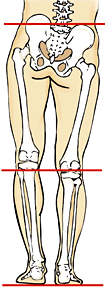You’re trying to get yourself back into shape, eating healthy, hitting the stair master, lifting or jogging… everything you’re supposed to do right. BUT, after a couple weeks your knees start to bug you. You wonder: “Am I doing too much? Am I too old for this? What am I doing wrong?” Someone suggests shoe inserts, someone says don’t buy inserts. What next?
Knee pain can be a tricky and is also one of the most common issues we see. The knee is the center point of what us PTs (or to-be PT in my case) call the “kinetic chain” of the lower limb. This kinetic chain involves the lower back, hip, knee, ankle and foot. Dysfunction at any part of this chain can be the underlying cause of knee pain. Determining where and why this dysfunction is occurring is the key to solving most knee issues.
One of the first things we try to determine is if your legs are resting in similar alignment, if  not we call this a leg length discrepancy. Leg length discrepancies generally fall into two broad categories: structural or functional.
not we call this a leg length discrepancy. Leg length discrepancies generally fall into two broad categories: structural or functional.
Structural discrepancies account for a very small percentage of what we see and stem from anatomical differences in the length or shape of the bones of the leg. This usually results from previous injury, illness or can be present from birth. Structural discrepancies are a little more challenging to treat  and sometimes require orthotics, inserts or other devices to help your body compensate for the anatomical differences.
and sometimes require orthotics, inserts or other devices to help your body compensate for the anatomical differences.
With functional discrepancies, all the bones are the right size and shape but aligned incorrectly. This can be caused by a variety factors like posture, muscle imbalances, restricted joints or training errors. Functional discrepancies are usually correctible with manual therapy to realign the bones and exercise techniques to help the correction to stick. Shoe inserts are typically not useful for functional discrepancies because they don’t correct the underlying alignment issue and can actually lead to more problems.
It’s impossible to create a single solution that will fix every individual person’s pain and discomfort. Interventions must be tailored to each patient’s unique profile. Before investing in a pricey pair of orthotics it’s important to determine if you are actually likely to benefit from their use or if you would be better off with corrections and therapeutic exercise
Kit Durban, SPT
Physical Therapy Student, Boston University
Synergy North Clinic
